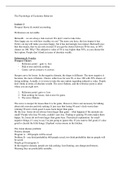The Psychology of Economic Behavior
Lecture 2
Prospect theory & mental accounting
Preferences are not stable.
Bernoulli – we are always risk-aversed. We don’t want to take risks.
How happy are we with how wealthy we are? The more you have, the less impact it has.
Extra’s on top will make you more happy, but it has increasingly less impact. Bernoulli says
that that means, that we are risk aversed. If you get the choice between 50 for sure, or 50%
chance on 100. Why? The subjective value of 50 is way higher than 50%, so you choose the
first option. People don’t think in terms of absolute wealth.
Kahneman & Tversky
Prospect Theory
- Reference point – gain vs. loss
- Risk averse and risk-seeking
- Cause: curves concave vs convex
Steeper curve for losses. In the negative domain, the shape is different. The more negative it
becomes, the more it flattens. Choice: either lose for sure 50, or lose 100 with 50% chance of
losing nothing. Actually, it is worse to take the sure option regarding subjective value. People
don’t think in terms of absolute wealth. The curve flattens, and the reference point is often
where you are right now.
1. Reference point: gain vs. loss
2. Risk seeking for losses, risk averse for gains.
3. The curve flattens
The curve is steeper for losses than it is for gains. However, this is not necessary for talking
about risk aversion and risk seeking. It just says that losing 50 euro’s feels worse than
winning 50 euro’s feels good. Losses loom larger than gains.
By the way: losses do not always loom larger than gains – what happens if the amounts are
small? People who lose 50 cents, couldn’t care less. Finding or gaining 50 cents makes them
happy. So, losses do not loom larger than gains here. Theoretical explanation: for small
negative things, it’s easy to say I’m just going to ignore this. If you want to feel good, it’s also
good to cherish the little things. Elephant versus mouse in the kitchen.
The Asian disease problem:
Positive domain
Program A – 200 people will be saved
Problem B – one third probability 600 people saved, two third probability that no people will
be saved.
People go for program A
In the negative domain, people are risk-seeking. Just framing, can change preferences.
Meaning they are predictably unstable.
, The endowment effect – people place higher value on an object they already own than
they would value that same object if they did not own it
People keep the object they received. They do not want to trade.
Morewedge & Giblin: endowment effect – a review
Endowment effect is (as a term) coupled to the loss aversion explanation. This does not mean
that valuation or reluctance to trade is only related to loss aversion. There are more things to
the story than just loss aversion.
1. Trading = losing and winning
2. Losses loom larger than gains
Which is why people are aversed to trading.
Why? Could be an evolutionary advantage (it helps you if you value what you have) –
evidence is not strong, cultural differences etc. Could also be a strategic misrepresentation,
true, but the effect remains. Another thing that they add, is reference prices. It could be that
buyers and sellers have different reference prices. Maybe buyers would never want to buy it
for more than market price. But maybe sellers attend more to highest reference price, buyers
to lowest. Biased into processing – buyers may focus on info suggesting that keeping money
is best and sellers may focus on info suggesting that keeping product is best. Another factor,
(mere) ownership: means that if you have a product, you start associating this with the self, it
becomes more or less part of you – emotional attachment. Self-referential memory effect:
things that are yours, you encode and recall that more easily.
- The reasoning with the endowment effect is completely different than the mere
ownership effect.
Other factors (not discussed) could be:
- Expertise: those who have a lot of expertise, were more susceptible to the endowment
effect – counterintuitive. Why? If you have a product, and you can trade it for another.
It is important (for endowment effect) that you see the trade as losing something and
getting something different in return. Experts know more about the differences, so
they see it as getting something different.
- Norms and receiving/exchanging presents. It is quite impolite to immediately trade
your gift.
- Type of goods.
The researchers put it on attention sampling bias: all factors we just mentioned affect which
attributes you focus on.
Mental accounting – Thaler
In our minds, we have different accounts. Topical accounts – different accounts for different
topics. We treat money differently in different accounts. For example, we treat money that we
get by income by work other than when you get money without working for it.
Willingness to consume is higher for windfall than for money you have worked for. It is spent
more easily from that account.




